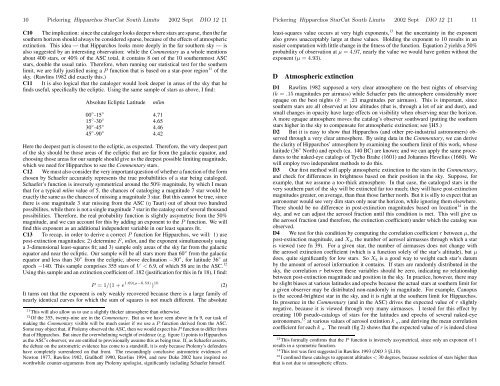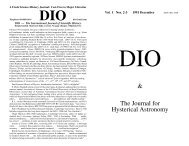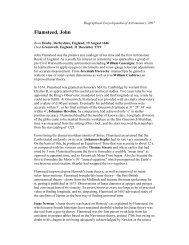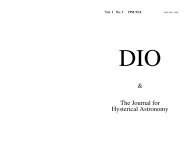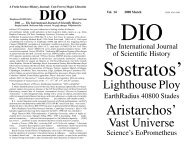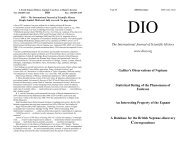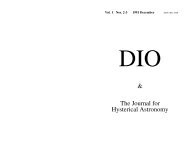The Ancient Star Catalog - DIO, The International Journal of ...
The Ancient Star Catalog - DIO, The International Journal of ...
The Ancient Star Catalog - DIO, The International Journal of ...
You also want an ePaper? Increase the reach of your titles
YUMPU automatically turns print PDFs into web optimized ePapers that Google loves.
10 Pickering Hipparchos <strong>Star</strong>Cat South Limits 2002 Sept <strong>DIO</strong> 12 ‡1<br />
C10 <strong>The</strong> implication: since the cataloger looks deeper where stars are sparse, then the far<br />
southern horizon should always be considered sparse, because <strong>of</strong> the effects <strong>of</strong> atmospheric<br />
extinction. This idea — that Hipparchos looks more deeply in the far southern sky — is<br />
also suggested by an interesting observation: while the Commentary as a whole mentions<br />
about 400 stars, or 40% <strong>of</strong> the ASC total, it contains 8 out <strong>of</strong> the 10 southernmost ASC<br />
stars, double the usual ratio. <strong>The</strong>refore, when running our statistical test for the southern<br />
limit, we are fully justified using a P function that is based on a star-poor region 11 <strong>of</strong> the<br />
sky. (Rawlins 1982 did exactly this.)<br />
C11 It is also logical that the cataloger would look deeper in areas <strong>of</strong> the sky that he<br />
finds useful, specifically the ecliptic. Using the same sample <strong>of</strong> stars as above, I find:<br />
Absolute Ecliptic Latitude<br />
mlim<br />
00 ◦ -15 ◦ 4.71<br />
15 ◦ -30 ◦ 4.65<br />
30 ◦ -45 ◦ 4.46<br />
45 ◦ -90 ◦ 4.42<br />
Here the deepest part is closest to the ecliptic, as expected. <strong>The</strong>refore, the very deepest part<br />
<strong>of</strong> the sky should be those areas <strong>of</strong> the ecliptic that are far from the galactic equator, and<br />
choosing those areas for our sample should give us the deepest possible limiting magnitude,<br />
which we need for Hipparchos to see the Commentary stars.<br />
C12 We must also consider the very important question <strong>of</strong> whether a function <strong>of</strong> the form<br />
chosen by Schaefer accurately represents the true probabilities <strong>of</strong> a star being cataloged.<br />
Schaefer’s function is inversely symmetrical around the 50% magnitude, by which I mean<br />
that for a typical mlim value <strong>of</strong> 5, the chances <strong>of</strong> cataloging a magnitude 7 star would be<br />
exactly the same as the chances <strong>of</strong> missing a magnitude 3 star. But this cannot be true, since<br />
there is one magnitude 3 star missing from the ASC (η Tauri) out <strong>of</strong> about two hundred<br />
possibilites, while there is not a single magnitude 7 star in the catalog out <strong>of</strong> several thousand<br />
possibilities. <strong>The</strong>refore, the real probability function is slightly assymetric from the 50%<br />
magnitude, and we can account for this by adding an exponent to the P function. We will<br />
find this exponent as an additional independent variable in our least squares fit.<br />
C13 To recap, in order to derive a correct P function for Hipparchos, we will: 1) use<br />
post-extinction magnitudes; 2) determine F , mlim, and the exponent simultaneously using<br />
a 3-dimensional least-squares fit; and 3) sample only areas <strong>of</strong> the sky far from the galactic<br />
equator and near the ecliptic. Our sample will be all stars more than 60 ◦ from the galactic<br />
equator and less than 30 ◦ from the ecliptic, above declination −30 ◦ , for latitude 36 ◦ at<br />
epoch −140. This sample comprises 355 stars <strong>of</strong> V < 6.9, <strong>of</strong> which 58 are in the ASC. 12<br />
Using this sample and an extinction coefficient <strong>of</strong> .182 (justification for this in fn 18), I find:<br />
P = 1/(1 + e 1.69(µ−6.53) ) 10 (2)<br />
It turns out that the exponent is only weakly recovered because there is a large family <strong>of</strong><br />
nearly identical curves for which the sum <strong>of</strong> squares is not much different. <strong>The</strong> absolute<br />
11 This will also allow us to use a slightly thicker atmosphere than otherwise.<br />
12 Of the 355, twenty-nine are in the Commentary. But as we have seen above in fn 9, our task <strong>of</strong><br />
making the Commentary visible will be much easier if we use a P function derived from the ASC.<br />
Some may object that, if Ptolemy observed the ASC, then we would expect his P function to differ from<br />
that <strong>of</strong> Hipparchos. But since the overwhelming weight <strong>of</strong> evidence (e.g. figure 1) points to Hipparchos<br />
as the ASC’s observer, we are entitled to provisionally assume this as being true. If, as Schaefer asserts,<br />
the debate on the astrometric evidence has come to a standstill, it is only because Ptolemy’s defenders<br />
have completely surrendered on that front. <strong>The</strong> resoundingly conclusive astrometric evidences <strong>of</strong><br />
Newton 1977, Rawlins 1982, Graßh<strong>of</strong>f 1990, Rawlins 1994, and now Duke 2002 have inspired no<br />
worthwhile counter-arguments from any Ptolemy apologist, significantly including Schaefer himself.<br />
Pickering Hipparchos <strong>Star</strong>Cat South Limits 2002 Sept <strong>DIO</strong> 12 ‡1 11<br />
least-squares value occurs at very high exponents, 13 but the uncertainty in the exponent<br />
also grows unacceptably large at these values. Holding the exponent to 10 results in an<br />
easier computation with little change in the fitness <strong>of</strong> the function. Equation 2 yields a 50%<br />
probability <strong>of</strong> observation at µ = 4.97, nearly the value we would have gotten without the<br />
exponent (µ = 4.93).<br />
D<br />
Atmospheric extinction<br />
D1 Rawlins 1982 supposed a very clear atmosphere on the best nights <strong>of</strong> observing<br />
(k = .15 magnitudes per airmass) while Schaefer puts the atmosphere considerably more<br />
opaque on the best nights (k = .23 magnitudes per airmass). This is important, since<br />
southern stars are all observed at low altitudes (that is, through a lot <strong>of</strong> air and dust), and<br />
small changes in opacity have large effects on visibility when observing near the horizon.<br />
A more opaque atmosphere moves the catalog’s observer southward (putting the southern<br />
stars higher in the sky to compensate for atmospheric extinction; see §H5.)<br />
D2 But it is easy to show that Hipparchos (and other pre-industrial astronomers) observed<br />
through a very clear atmosphere. By using data in the Commentary, we can derive<br />
the clarity <strong>of</strong> Hipparchos’ atmosphere by examining the southern limit <strong>of</strong> this work, whose<br />
latitude (36 ◦ North) and epoch (ca. 140 BC) are known; and we can apply the same procedures<br />
to the naked-eye catalogs <strong>of</strong> Tycho Brahe (1601) and Johannes Hevelius (1660). We<br />
will employ two independent methods to do this.<br />
D3 Our first method will apply atmospheric extinction to the stars in the Commentary,<br />
and check for differences in brightness based on their position in the sky. Suppose, for<br />
example, that we assume a too-thick atmosphere. In that case, the cataloged stars in the<br />
very southern part <strong>of</strong> the sky will be extincted far too much; they will have post-extinction<br />
magnitudes greater, on average, than than those farther north. But it is silly to expect that an<br />
astronomer would see very dim stars only near the horizon, while ignoring them elsewhere.<br />
<strong>The</strong>re should be no difference in post-extinction magnitudes based on location 14 in the<br />
sky, and we can adjust the aerosol fraction until this condition is met. This will give us<br />
the aerosol fraction (and therefore, the extinction coefficient) under which the catalog was<br />
observed.<br />
D4 We test for this condition by computing the correlation coefficient r between µ, the<br />
post-extinction magnitude, and X a, the number <strong>of</strong> aerosol airmasses through which a star<br />
is viewed (see fn 39). For a given star, the number <strong>of</strong> airmasses does not change with<br />
the aerosol extinction coefficient (which is a function solely <strong>of</strong> the star’s altitude), but µ<br />
does, quite significantly for low stars. So X a is a good way to weight each star’s datum<br />
by the amount <strong>of</strong> aerosol information it contains. If stars are randomly distributed in the<br />
sky, the correlation r between these variables should be zero, indicating no relationship<br />
between post-extinction magnitude and position in the sky. In practice, however, there may<br />
be slight biases at various latitudes and epochs because the actual stars at southern limit for<br />
a given observer may be distributed non-randomly in magnitude. For example, Canopus<br />
is the second-brightest star in the sky, and it is right at the southern limit for Hipparchos.<br />
Its presence in the Commentary (and in the ASC) drives the expected value <strong>of</strong> r slightly<br />
negative, because it is viewed through very many airmasses. I tested for this effect by<br />
creating 100 pseudo-catalogs <strong>of</strong> stars for the latitudes and epochs <strong>of</strong> several naked-eye<br />
astronomers, 15 at various values <strong>of</strong> aerosol extintion k a, and deriving the mean correlation<br />
coefficient for each k a. <strong>The</strong> result (fig 2) shows that the expected value <strong>of</strong> r is indeed close<br />
13 This formally confirms that the P function is inversely assymetrical, since only an exponent <strong>of</strong> 1<br />
results in a symmetric function.<br />
14 This test was first suggested in Rawlins 1993 (<strong>DIO</strong> 3 §L10).<br />
15 I confined these catalogs to apparent altitudes < 30 degrees, because seelction <strong>of</strong> stars higher than<br />
that is not due to atmospheric effects.


